Antibody data
- Antibody Data
- Antigen structure
- References [1]
- Comments [0]
- Validations
- Immunocytochemistry [1]
- Immunohistochemistry [1]
- Flow cytometry [2]
- Other assay [2]
Submit
Validation data
Reference
Comment
Report error
- Product number
- PA5-71475 - Provider product page

- Provider
- Invitrogen Antibodies
- Product name
- ASXL1 Polyclonal Antibody
- Antibody type
- Polyclonal
- Antigen
- Synthetic peptide
- Reactivity
- Human, Mouse
- Host
- Rabbit
- Isotype
- IgG
- Vial size
- 400 μL
- Concentration
- 0.5 mg/mL
- Storage
- Store at 4°C short term. For long term storage, store at -20°C, avoiding freeze/thaw cycles.
Submitted references ASXL1 promotes adrenocortical carcinoma and is associated with chemoresistance to EDP regimen.
Wang L, Lyu Y, Li Y, Li K, Wen H, Feng C, Li N
Aging 2021 Sep 18;13(18):22286-22297
Aging 2021 Sep 18;13(18):22286-22297
No comments: Submit comment
Supportive validation
- Submitted by
- Invitrogen Antibodies (provider)
- Main image
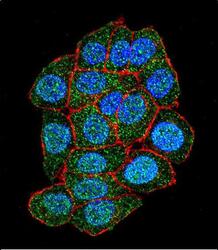
- Experimental details
- Immunocytochemistry analysis of ASXL1 in HeLa cells. Samples were incubated in ASXL1 polyclonal antibody (Product # PA5-71475) followed by Alexa Fluor 488-conjugated goat anti-rabbit lgG (green). Actin filaments have been labeled with Alexa Fluor555 phalloidin (red). DAPI was used to stain the cell nuclear (blue).
Supportive validation
- Submitted by
- Invitrogen Antibodies (provider)
- Main image
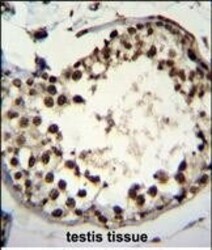
- Experimental details
- Immunohistochemistry analysis of ASXL1 in formalin fixed and paraffin embedded human testis tissue. Samples were incubated with ASXL1 polyclonal antibody (Product # PA5-71475) followed by peroxidase conjugation of the secondary antibody and DAB staining. This data demonstrates the use of this antibody for immunohistochemistry. Clinical relevance has not been evaluated.
Supportive validation
- Submitted by
- Invitrogen Antibodies (provider)
- Main image
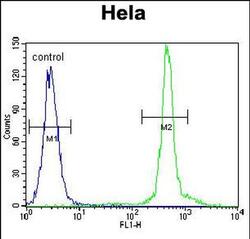
- Experimental details
- Flow cytometry analysis of ASXL1 in HeLa cells (right histogram) compared to a negative control cell (left histogram). Samples were incubated with ASXL1 polyclonal antibody (Product # PA5-71475) followed by a FITC conjugated goat anti-rabbit secondary antibody.
- Submitted by
- Invitrogen Antibodies (provider)
- Main image
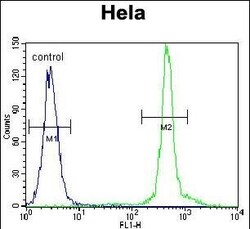
- Experimental details
- Flow cytometry of ASXL1 in Hela cells (right histogram). Samples were incubated with ASXL1 polyclonal antibody (Product # PA5-71475) followed by FITC-conjugated goat-anti-rabbit secondary antibody. Negative control cell (left histogram).
Supportive validation
- Submitted by
- Invitrogen Antibodies (provider)
- Main image
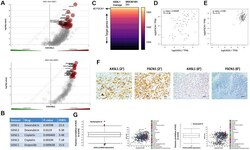
- Experimental details
- Figure 2 Expressions of ASXL1 and FSCN1 was positively correlated. Reproduced from the GDSC dataset, shown were volcano plots of drug sensitivity of gain of cytoband encompassing ASXL1 in pan-cancer cell lines from ( A ) GDSC1 and GDSC2 repositories and ( B ) retrieved P values for Doxorubicin, Etoposide and Cisplatin; ( C ) Reproduced from ChIP-Atlas, shown was heatmap ranked by binding score of ASXL1 from high to low in different model cells (human 293 cells), each row representing one gene; ( D ) Reproduced from the TCGA adrenocortical carcinoma (ACC) dataset, shown was expression correlation between ASXL1 and FSCN1 in ACC samples; ( E ) Reproduced from the GTEx dataset, shown was expression correlation between ASXL1 and FSCN1 in normal adrenal samples; ( F ) Representative IHC image of ASXL1 and FSCN1 staining in ACC samples with numbers indicating IHC score; ( G ) Reproduced from The Cancer Therapeutics Response Portal, shown were box plots of correlation coefficients between area under control and gene expression in cancer cells.
- Submitted by
- Invitrogen Antibodies (provider)
- Main image
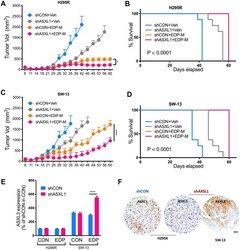
- Experimental details
- Figure 5 ASXL1 silencing sensitized ACC cells to etoposide, doxorubicin, cisplatin and mitotane (EDP-M) regimen. Xenograft murine models consisting of 8 male BALB/c nude mice per group undergoing EDP-M regimen () or vehicle control (Veh) with subcutaneous implanted with ( A ) NCI-H295R cells with or without ASXL1 silencing under left flank with tumor growth monitored over 60-day period and tumor size of < 2000 mm 3 as endpoint, and ( B ) Kaplan-Meier curves of survival of mice; and with ( C ) SW-13 cells with or without ASXL1 silencing under left flank with tumor growth monitored over 60-day period and tumor size of < 2000 mm 3 as endpoint, and ( D ) Kaplan-Meier curves of survival of mice; ( E ) Quantitative PCR showing expression of ASXL3 in ACC cell lines treated with EDP regimen; ( F ) Representative image of immunohistochemical staining of ASXL1 and ASXL3 in harvested tumors from xenograft models (scale bar = 100 mum, *P < 0.05; **P < 0.01; ***P < 0.001; ****P < 0.0001).
 Explore
Explore Validate
Validate Learn
Learn Western blot
Western blot Immunocytochemistry
Immunocytochemistry